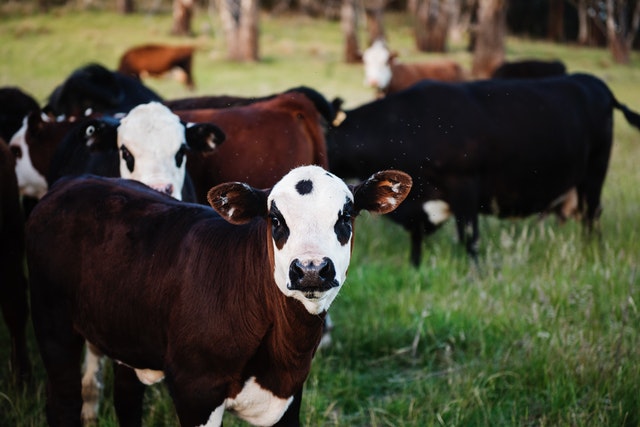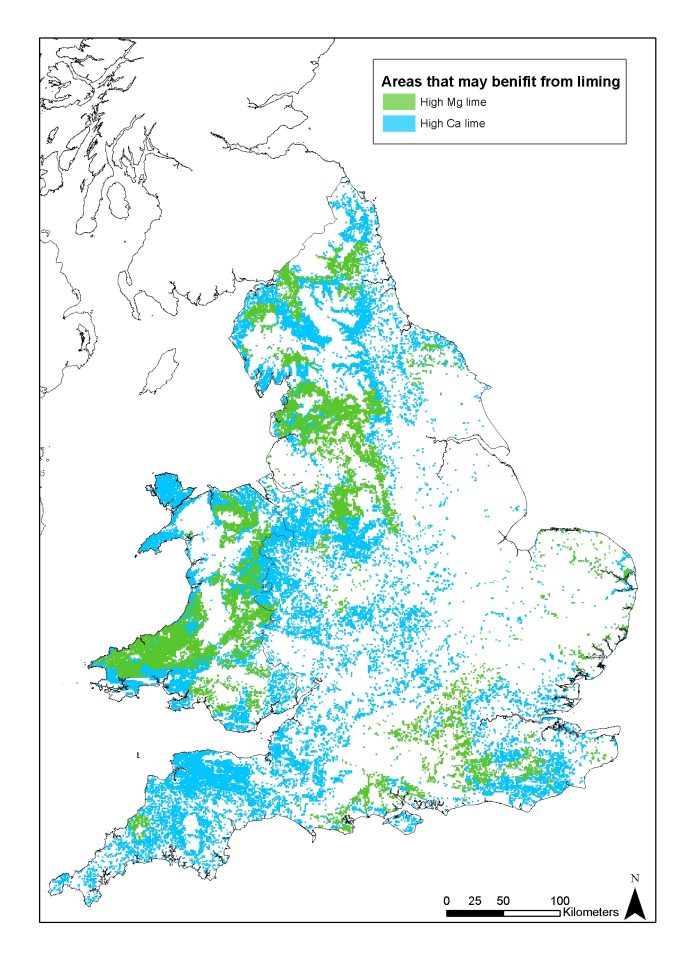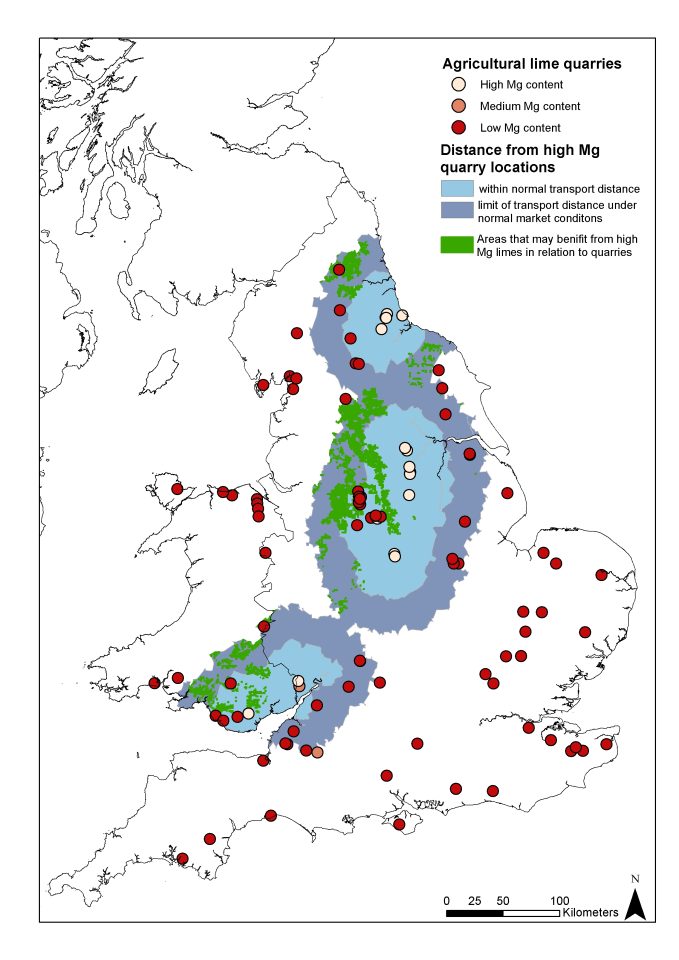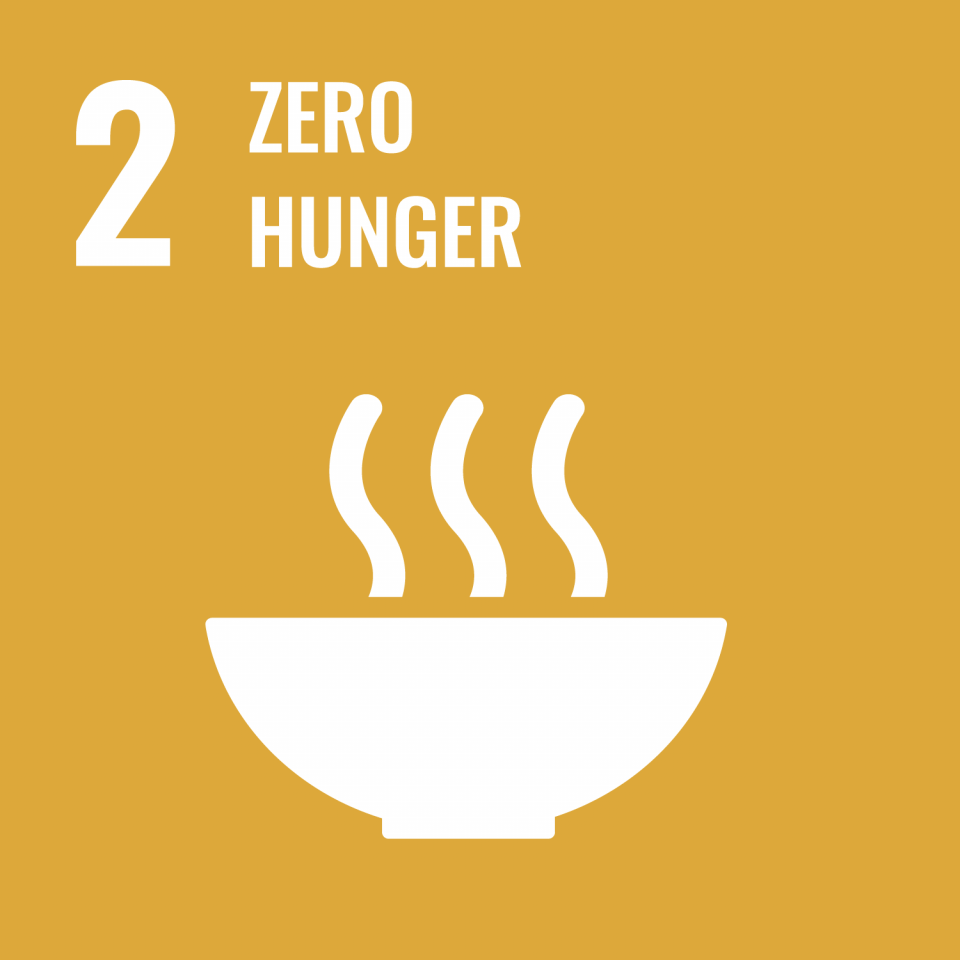Scientists analyse lime resources in the UK
A study by BGS scientists could help to improve soil magnesium concentrations and pH in grassland areas of England and Wales, with benefits for UK agriculture and farming.
25/10/2021 By BGS Press
Published in Scientific Reports by Nature, a study by scientists at BGS provides a spatial analysis of lime resources in England and Wales and sets out to determine if magnesium-rich lime products could be used more effectively in agricultural production systems.
In a collaborative project led by BGS, experts used publicly available datasets to identify potential resources of carbonate rocks, such as limestone, dolostone and chalk, in the UK, and their magnesium and calcium status.
The data was combined with the locations of agricultural lime quarries and areas where soils are likely to be deficient in magnesium and may require liming. New data developed during the research will be added to the UK Soils Observatory, the free-to-access online archive of UK soils data from nine major research bodies.
The benefits of agricultural lime products
Magnesium is an essential plant nutrient that plays a key role in plant growth and is essential for animal health. Low magnesium status, known as hypomagnesaemia, can be potentially fatal for cattle and sheep and is widespread in Europe, with economic impacts on farming.
Effective prevention of magnesium deficiency benefits both animal welfare and economic productivity.
Applying magnesium-rich agricultural lime products can help to maintain healthy soil pH levels and ensure that magnesium levels in livestock feed is at sufficient levels, helping animals to get essential dietary nutrients.
Agricultural lime is any calcium carbonate or magnesium carbonate-rich form of crushed rock (limestone, dolostone or chalk) that is applied to soil. It is used to reduce soil acidity, optimising soil pH levels for grass growth in pastures.
Despite this, the use of preventative measures and pasture interventions, including the application of magnesium-rich fertiliser or lime products, is reportedly low.

Map showing areas of the UK that may benefit from agricultural lime products. BGS © UKRI. Some features of this map are based on digital spatial data licensed from the UK Centre for Ecology & Hydrology. Contains Ordnance Survey data © Crown copyright and database rights 2021.
A geological challenge
Dietary supply of magnesium can be a challenge for farming and agriculture because magnesium concentrations are heavily dictated by geological factors, including soil type.
The magnesium content of soil relates to that of the bedrock. Where it is high in the bedrock it tends to be naturally high in soil and vice versa. That means the composition of all pasture and farm-grown fodder will always be influenced by this natural environmental endowment.
Tom Bide, BGS Minerals Geoscientist.
As well as the source rock, magnesium concentrations in soils are also controlled by other environmental factors, including climate, rainfall, degree of weathering, cropping intensity and fertilisation practices.
Environmental factors also contribute to low pH in soils. Added to this, the application of nitrogen fertilisers can have an acidifying effect.
A challenge for agriculture is that it is both labour and resource intensive to identify and treat areas of low pH and magnesium. To assist with this problem, scientists have used readily available spatial datasets and accessible legacy survey data to develop decision-making information, which can assist preliminary assessments of soil and forage nutrition. Such integration of datasets can add to the understanding of the supply and demand dynamics of agricultural lime in England and Wales, ensuring that the most realistic and appropriate resource management strategies are applied.
The supply and demand dynamics of agricultural lime in England and Wales
The study, by scientists at BGS in collaboration with the University of Nottingham, has combined geological and environmental data to demonstrate where supply could potentially meet demand.
We used datasets that provide an understanding of where grasslands may have pH values that indicate liming would be beneficial, and where those may coincide with low plant-available soil magnesium concentrations. This was combined with a comprehensive database of mines and quarries in the UK.
What we found is that the areas of England and Wales where magnesium deficiency and low pH are most likely to co-occur are seen in mid-Wales and parts of south-west, north-west and the Midlands of England.
Despite this, areas where liming may be an effective solution to low soil magnesium were often found to be likely to be restricted by the availability of suitable products.
Tom Bide, BGS Minerals Geoscientist.
Balancing demand with supply
In terms of demand, analysis shows that 18 per cent of the study area may be both suitable for and require liming with calcium liming material and 8 per cent with magnesium liming material.
When it came to supply, in total 96 potential supply sites were identified. Of these sites, only 14 have the potential to produce high magnesium lime and 29 have the potential to produce high calcium lime.
Our spatial analysis shows that, for many areas, the distance from source to market for magnesium-rich liming material is substantial. However, for some areas, such as around the East Midlands, South Yorkshire and south-west Wales, the application of high-magnesium limes could be a practical solution for livestock magnesium deficiencies
For many areas, other methods of magnesium intervention may be preferable, for example by application of processed magnesium additives or planting of magnesium-rich forage.
This is in contrast with high-calcium lime, for which much of England and Wales are in areas in proximity to quarries that can supply this material. These sites, like limestone resources, are widely spread across England and Wales. The wide distribution and existing supply chain for high-calcium limes means these products are readily available for the vast majority of lowland grasslands in England and Wales.
Tom Bide, BGS Minerals Geoscientist
The authors are keen to note that the study only was only concerned with crushed and ground liming products that comprise untreated quarried and crushed geological material. These did not include lime produced from food manufacture by-products or sites that may only supply lime for cement and mortar uses.
What we can conclude is that high magnesium and calcium agricultural limes may have wider market use than is currently realised, as shown in farm practice and trade statistics data. This analysis specifically shows that, in certain areas, the use of high-magnesium lime for soil treatment is a viable possibility for the dual benefit of altering pH and increasing soil magnesium content.
Tom Bide, BGS Minerals Geoscientist.

Map showing location of agricultural lime quarries in the UK with high, medium and low magnesium content plotted against their distance from high-magnesium quarry locations. BGS © UKRI. Some features of this map are based on digital spatial data licensed from the UK Centre for Ecology & Hydrology. Contains Ordnance Survey data © Crown copyright and database rights 2021.
Making data available to inform future decision making
The analysis also highlights the opportunity for farmers, agronomists and other users to benefit from the huge range of existing, publicly available data that may not always appear accessible to potential users outside the geological sciences.
We hope this study provides information that can help to guide on-farm decision making for use of magnesium-rich and other lime resources. This could be used in conjunction with other options to reduce risks of magnesium deficiency in livestock, and improve soil pH.
Tom Bide BGS Minerals Geoscientist.
Data from the study will be made available in the UK Soil Observatory map viewer.
Funding
This work was funded jointly by the Biotechnology and Biological Sciences Research Council (BBSRC) and the Natural Environment Research Council (NERC) with the members of the Sustainable Agriculture Research and Innovation Club (SARIC).
Sustainable Development Goals
This BGS research directly addresses UN Sustainable Development Goals (SDGs) to increase the sustainability, productivity and resilience of agriculture and raise animal welfare standards.

SDG 2: zero hunger. The food and agriculture sector offers key solutions for development and is central for hunger and poverty eradication.





